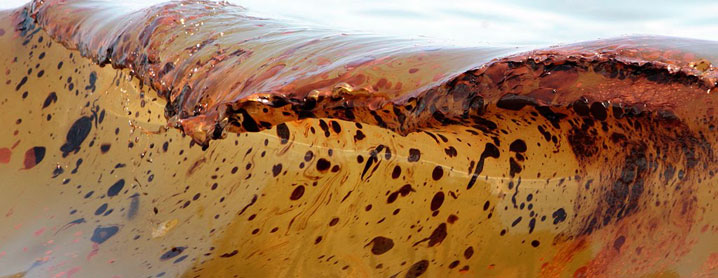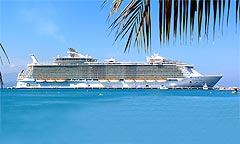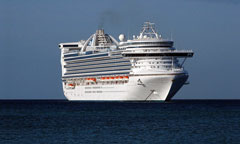The Cruise Industry
Environmental Issues
Pollutants
Pollutants and waste derived from activities aboard cruise ships, with different environmental repercussions.

Pollutants and waste derived from activities aboard cruise ships, with different environmental repercussions.

There are different pollutants and waste derived from diverse activities and processes aboard cruise ships. In some cases they are classified as a hazardous waste according to current national and international pollution prevention regulations, depending on factors of ignitability, corrosive potential, reactivity and toxicity.
Blackwater, also known as brown water, foul water or sewage, is a term used to describe water containing fecal matter and urine.
Blackwater is wastewater collected by toilets and medical sinks and facilities, which can contains hazardous pathogens, intestine parasites, including faecal coliform bacteria, viral agents and chemical nutrients that need to decompose before being released into environment.
Blackwater is a harmful waste that must be adequately treated before being disposed of into marine waters. In other case, it can cause a serious contamination of fisheries and shellfish beds, resulting in a general contamination of the food chain and a risk to human health by transmitting infectious diseases such as typhoid fever, infectious hepatitis, gastroenteritis or dysentery.
In the other hand, there are a series of chemical nutrients in sewage, such as phosphorus and nitrogen. Under certain conditions, these compounds fuel eutrophication, causing excessive algal blooms, which can degrade aquatic habitats by reducing light levels and producing certain toxins, some of which are also harmful for human life.
Greywater is wastewater generated from domestic, non-industrial processes, including drainage from dishwasher, galley taps, laundry facilities, showers, bath and washbasin drains, etc.
This wastewater receives its definition from both its own appearance and from the fact that it cannot be considered neither fresh water, nor heavily polluted wastewater.
Greywater is usually kept separate from blackwater to reduce the amount of water that gets heavily polluted, and it is typically the largest source of liquid waste produced by a cruise ship (around 50-80%).
Greywater can contain a wide variety of pollutant substances at different strengths, including oil and some organic compounds, hydrocarbons, detergents and grease, metals, suspended solids, chemical nutrients, food waste, coliform bacteria and some medical and dental waste. Nevertheless, it is distinct from blackwater in the presence and concentration of faeces and toxins as determinant biological and chemical contaminants.
Graywater is collected in tanks aboard cruise ships and, as required by operational procedures and allowed by regulations, discharged overboard through multiple ports below the ship’s waterline by motor-driven centrifugal pumps, depending on many factors such as planned itinerary, ship location or waste generation rate.
The area of the ship at the very bottom of the hull is known as the bilge, where water collects from diverse mechianical processes, such as engines, water-lubricated shaft seals, propulsion system cooling, evaporators and other ancillary and maintenance machinery. In this area, water mixes with oil, gasoline, rags, metal shavings, paint, grass and cleaning agents and a diversity of by-products from the biological breakdown of hydrocarbons on board.
A large cruise ship can generate several tons of bilge water in a day.
Bilge spaces should be periodically pumped dry to maintain ship stability and eliminate potential hazardous conditions derived from such substances and their respective interaction, which require complex and sophisticated equipment for its extraction, retention, treatment and reuse or discharge in compliance with regional and international environmental regulations.
Oily bilge water contain a wide range of pollutants and oxygen-demanding agents, and have various chronic physiological effects, including cancer-causing ones, posing a real threat to aquatic ecosystems and human life, even in minute quantities.
All ships are required to have equipment installed onboard that limits the discharge of bilge water into the oceans to concentrations between 10 and 15 parts per million when a ship is en route, and provided the ship is not in a special area where all discharge of this type is prohibited.
Ballast water is carried in unladen ships to provide stability, for example to offset the weight of fuel consumed during the voyage.
Ballast water is taken on at port in one region and discharged in another in a process involving the discharge of up to 1,000 metric tons of water, which includes a myriad of undesirable passengers; invasive species as a top threat to biodiversity, fisheries and aquaculture.
During the voyage, temperature differential and other factors in the ballast water kill many of these organisms. Nevertheless, many of them survive and become pests that smother local fauna, deplete native populations and deprive them of food, thus posing public health and environmental risks, as well as significant economic cost to diverse industries.
Although the cruise industry contributes the least to total nitrogen and sulphur emissions in relation to the whole maritime sector, with 5% and 6% respectively, a cruise ship produces roughly the equivalent in exhaust emissions of 12,000 automobiles or an average power plant by onboard diesel engines, ancillary equipment and incineration units.
Combustion of high sulphur content fuel produces nitrogen oxide, carbon monoxide and dioxide, sulphur dioxide and other harmful hydrocarbons that contribute to a wide range of atmospheric pollutant phenomena, which may cause serious health problems, including respiratory diseases, neurological damage, birth defects or cancer, and determine a general increase in mortality rate even at low concentrations.
Diesel emissions from cruise ships are particularly worrying while at port, and especially significant for coastal communities and surrounding areas, considering that one-third of these emissions occur while the ship is docked. Auxiliary diesel machinery, systems to power lights, pumps, refrigeration equipment and many other onboard functions are a significant source of air pollution, and it has been estimated that a large cruise ship visiting port can pump out as much air pollutants as 2,000 cars and trucks driving in one year.
Solid waste and garbage include cardboard, diverse metallic waste (mostly aluminium and steel cans), glass, paper and plastic.
Management of shipboard generated waste is an important issue for all maritime companies.
An average cruise ship generates around 3.5 kilograms of solid waste per passenger and crewmember everyday. With thousands of passengers and crewmembers aboard a single ship, the amount of solid waste and garbage generated in a single day can be massive.
It is difficult to determine the amount of solid waste generated by the cruise industry worldwide, with important discrepancies in the calculation of even an approximate quantity. Thus, an study carried out in the United States in 1995 showed that cruise ships generated the 51.4% of the total annual garbage produced by the whole U.S. maritime sector. Nevertheless, and few years later, the National Research Council estimated that such quantity amounted only to 19% of the total.
In any case, such figures represent the amount of solid waste generated on board; not the amount of waste disposed of in compliance with waste disposal regulations and protocols.
This type of waste dumped to the ocean may become marine debris and a threat to the ecosystem and coastal communities.
The potential impact from pollution by solid waste on the open ocean and coastal environment can be significant, with a diversity of effects and consequences:
The cruise industry manages this problem by a variable combination of waste minimization, recycling and incineration. Thus, an amount of garbage is retained onboard and landed onshore for recycling in processing plants, a certain percentage is incinerated onboard and the ash discharged at sea, and some solid waste (food and other organic waste) is also disposed of into the ocean.
Ash generated in the incineration of waste is not normally a hazardous waste if items that would cause the ash to be hazardous are previously separated from the waste stream and handled according to accepted hazardous waste regulations.
In other case, incineration generates several forms of waste itself, such as the emission of unburned gases and metals, and hazardous byproducts of combustion, such as dioxins, furans and heavy metals that are released into the air.
A cruise ship can produce around 15 gallons of hazardous waste every day, which includes, among others, some medical waste and outdated pharmaceuticals, dry cleaning sludge, batteries, photofinishing chemicals and other expired chemicals, paint waste and thinners, fluorescent lamps, etc.
These materials contain a wide diversity of harmful substances and compounds that can pose serious health and environmental hazards, such as hydrocarbons, chlorinated hydrocarbons and heavy metals, which require a safe management and disposal.
Used photographic and X-Ray development fluids may be assumed to be a hazardous waste, which includes spent fixer, expired film, silver flake, etc.
Photographic fixer removes the unexposed silver compounds from the film during the developing process, with a concentration of around 2000-3000 parts per million of residual silver particles (hazardous if its level exceeds 5 ppm).
Silver compounds and other chemical waste must be neutralized, detoxified and undergo removal of silver and other heavy metals before it can be landed it ashore or discharged in accordance with diverse national and international pollution prevention regulations.
Increased use of laser and photo copying equipment onboard cruise ships results in the generation of waste toner material and printing/copying cartridges that can contain hazardous chemical components.
In addition, this waste may contain hazardous fluid waste, such as inks, cleaner and printing solvents, which content hydrocarbons, chlorinated hydrocarbons, heavy metals and diverse chemical combinations that can be harmful to aquatic ecosystems and human life.
Shipboard dry cleaning facilities use a chlorinated solvent called perchlorethylene as a cleaning fluid, and produce a small volume of waste from contaminated sludge, spent solvent, filter materials, internal elements of recovery stills, lint traps and other parts of these units.
Each cruise ship utilizing these cleaning units produces a variable amount of this waste material, classified as hazardous waste, depending on the season and number of passengers on board, which imposes the necessity of properly trained technical personnel for the correct use and disposal of these chemicals in accordance with all safety procedures.
Health and medical departments aboard large cruise ships manage a wide range and amount of pharmaceuticals in an inventory based on their itinerary and other variables, from over-the-counter products to specific prescription drugs and specialty medications.
Fluorescent lamps contain phosphor powder, and mercury vapour lamps contain mercury. Both these two types of lamps could potentially be hazardous to the environment and the human health, and must be therefore handled in an environmentally safe manner.
Batteries are a very common power source for both onboard equipment and for passenger’s devices. If not properly handled and disposed of, spent batteries may pose a serious environmental risk and a threat to human health.
There are four basic types of batteries:
Lead-Acid Batteries: Used in standby generators and other auxiliary equipment, these batteries are the oldest type of rechargeable battery, containing a sponge lead anode, a lead dioxide cathode and sulphuric acid electrolyte.
Lead has been linked to serious effects on human health, and sulphuric acid is one of the most corrosive chemicals. Therefore, lead-acid batteries are a classified hazardous waste that can endanger human health and the environment if not properly disposed of.
Nickel-Cadmium (NiCd) Batteries: This type of battery is also rechargeable, and contain wet or dry potassium hydroxide as electrolyte.
Cadmium is a characteristic hazardous waste and accumulative poison, classified as a renal and hepatic toxin, with neurotoxic effects and a osteoporosis-causing agent.
The potassium hydroxide is corrosive, poisonous and may potentially generate explosive hydrogen gas upon contact with aluminium, tin, lead or zinc.
Lithium Batteries: This batteries are used in a wide variety of both scientific equipment and personal electrical devices.
They are all potentially hazardous. Lithium is a mildly toxic chemical, but not a listed or characteristic toxic hazardous waste. Waste lithium batteries can be considered a reactive hazardous waste if there is a significant amount of unconsumed or unreacted lithium remaining in the spent battery. Once these batteries are fully or mostly discharged, they can be disposed of as non-hazardous waste.
Nevertheless, lithium batteries may content other elements, such as cobalt, which is carcinogenic.
Alkaline Batteries: Also known as primary or non-rechargeable batteries, they are composed of a positive pole (anode) that contains zinc, and a negative pole (cathode) that contains manganese dioxide. Potassium hydroxide electrolyte, a strong alkali agent, is also contained within the cells of alkaline batteries. Added mercury has been eliminated from alkaline batteries since 1990s.
Because alkaline batteries do not exhibit the characteristics to be classified as a reactive or ignitable waste, and because the batteries do not meet the required definitions to be a corrosive waste, alkaline batteries may be regulated as universal wastes and subject to less stringent requirements than other hazardous wastes and can be disposed of as general trash.
However, there are more rigorous regulations with requirements that include bioassay. In fact, if the extracted leachate from an alkaline battery is diluted with water and used to conduct a bioassay, it is lethal to the test animals and harmful to human health. Therefore, some regulations include all types of batteries as special waste.

If you are interested in working on cruise ships and looking for the moment to access the sector, do not miss the opportunity to apply for a shipboard position in 2024.
Enter
The maritime cluster offers considerable job opportunities to workers and professionals unemployed or seeking for an occupational change.
Enter
There is a large diversity of positions and jobs to be filled aboard cruise ships.
We would like to offer you a listing of the most in-demand positions in this segment of the maritime sector.
EnterWorking in the cruise sector is an option for an increasing number of people and professionals seeking for a well-remunerated job in a dynamic working environment with career prospects.

Please do not hesitate to contact us.
EnterWe are open to receive – and we shall reply – any inquiry or request for information about the cruise industry and its job opportunities and for career development.

Contact Wind Rose Network
Contact